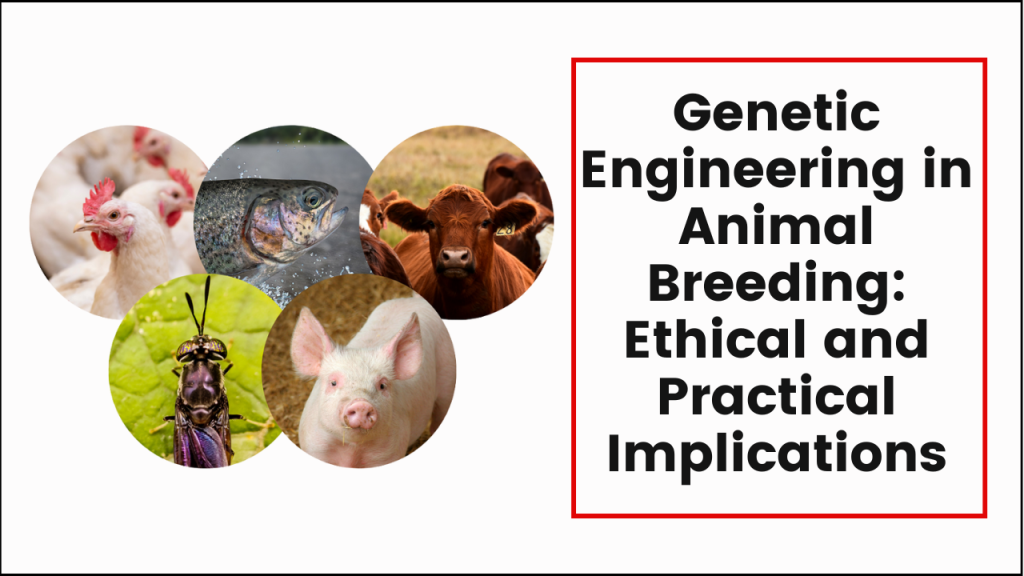
In recent years, genetic engineering has made significant inroads into the field of animal breeding, reshaping both the scientific and ethical landscape of animal husbandry. From increasing productivity to enhancing disease resistance, genetic modification holds immense potential. However, it also raises a host of ethical, ecological, and socio-economic concerns. As technology advances, the time is ripe for a deeper discussion on the implications of applying genetic engineering in animal breeding.
Table of Contents
Understanding Genetic Engineering in Animal Breeding
Genetic engineering involves the direct manipulation of an organism’s DNA to introduce desirable traits or eliminate undesirable ones. In the context of animal breeding, this technology goes far beyond traditional selective breeding methods. Techniques like CRISPR-Cas9 and recombinant DNA technology allow scientists to make precise changes in the genome, enabling the creation of animals that grow faster, produce more milk or meat, or resist specific diseases.
For example, genetically modified pigs have been developed to be resistant to Porcine Reproductive and Respiratory Syndrome (PRRS), a disease that costs the swine industry millions each year. Similarly, gene editing has been used to produce hornless dairy cattle, eliminating the need for dehorning and improving animal welfare.
Practical Benefits of Genetic Engineering
- Enhanced Productivity: Genetic engineering can lead to faster growth rates, improved feed conversion ratios, and higher yields in livestock. This is particularly valuable in meeting the protein demands of a growing global population.
- Disease Resistance: Genetic modifications can help animals resist certain infectious diseases, reducing dependency on antibiotics and minimizing the risk of zoonotic outbreaks.
- Improved Animal Welfare: Modifications such as producing hornless cattle or pigs with better stress tolerance may improve the living conditions and welfare of farm animals.
- Environmental Sustainability: By making animals more efficient in converting feed into protein, genetic engineering can reduce the environmental footprint of animal agriculture, including greenhouse gas emissions and land use.
Ethical and Moral Considerations
Despite its advantages, genetic engineering in animal breeding raises several ethical questions:
- Animal Welfare: Critics argue that genetic modifications may lead to unintended consequences, such as pain, deformities, or reduced quality of life. For example, overly muscular animals bred for more meat may suffer from mobility issues.
- Integrity of Nature: Some ethicists believe that altering an animal’s genetic code interferes with the natural order and represents an overreach of human authority over nature.
- Consent and Autonomy: Since animals cannot consent, the question arises whether it is justifiable to modify them for human benefit, especially when the modifications may not always serve the animal’s best interests.
- Commodification of Animals: Treating animals as mere tools or products to be optimized can desensitize people to their sentience and inherent value, potentially leading to widespread abuse.
Ecological and Socio-Economic Implications
Introducing genetically modified animals into the environment can have unpredictable ecological effects. For instance, if such animals were to escape or interbreed with wild populations, it could disrupt ecosystems or lead to genetic pollution.
From a socio-economic perspective, the use of genetically engineered animals could widen the gap between large agribusinesses and small farmers. Access to such advanced technologies may be limited by cost, intellectual property rights, and lack of infrastructure in developing countries.
There are also concerns about consumer acceptance. Public opinion is often divided over genetically modified organisms (GMOs), and transparency in labeling and regulation will play a crucial role in shaping public trust.
The Regulatory Landscape
Currently, the regulation of genetically modified animals varies across countries. In the United States, the Food and Drug Administration (FDA) regulates genetically engineered animals as veterinary drugs. In contrast, the European Union has adopted a more cautious approach, with stringent restrictions and a precautionary principle guiding their policies.
India is still in the early stages of developing a comprehensive regulatory framework for genetically engineered animals. Given the country’s diverse agricultural base and reliance on smallholder farmers, a nuanced and inclusive regulatory system is essential.
The Path Forward
The integration of genetic engineering into animal breeding is not inherently good or bad—it depends on how it is used, by whom, and for what purposes. A balanced approach is needed, one that maximizes the benefits while minimizing the risks.
Key Recommendations:
- Ethical Oversight: Establish independent ethics committees to review and guide genetic engineering projects in animal breeding.
- Public Dialogue: Foster transparent conversations with the public to address concerns and increase awareness of the science and its implications.
- Equitable Access: Ensure that small-scale farmers and developing countries are not left behind in the biotech revolution.
- Sustainability Focus: Prioritize applications that enhance sustainability, biodiversity, and animal welfare over purely commercial interests.
Conclusion
Genetic engineering in animal breeding stands at a crossroads of innovation and responsibility. While it promises a new boundary in livestock productivity and health, it also compels us to reconsider our moral obligations toward the animals we depend on. The choices we make today will shape not just the future of animal agriculture but also the ethical foundation of our relationship with other living beings.





